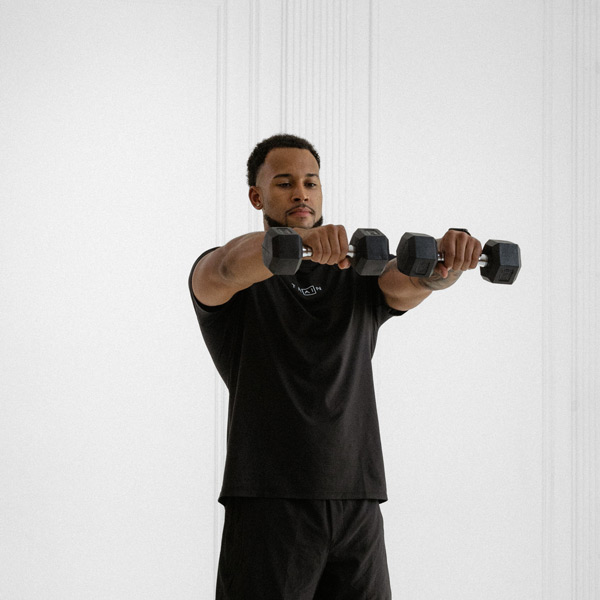Dumbbell Powell Raise
A unilateral side-lying dumbbell raise that targets the lateral deltoids for shoulder hypertrophy, stability, and rehabilitation; emphasizes controlled isolation with minimal trapezius involvement.
About Exercise
Equipment
Dumbbells, Flat Bench
Difficulty
3/5 • Intermediate
Primary Muscle Groups
Shoulders
Secondary Muscles
Shoulders, Shoulders, Traps
Accessory Muscles
Abs
Popularity Score
5
Goals
Training Style
Setup Requirements
Requires Rack
No
Requires Bench
Yes
Requires Spotter
No
Space Needed
Small
Noise Level
Low
Muscle Breakdown
View Muscle MapShoulders
10/10Medial Delts
Shoulders
5/10Anterior Delts
Shoulders
4/10Rear Delts
Traps
3/10Upper Traps
Abs
2/10Rectus Abdominis
Programming
Typical Rep Range
10-20 reps
Rest Between Sets
60-90 seconds
How to Perform
Lie on your side on a flat bench with legs secured to prevent movement. Hold a light dumbbell in your top hand with a neutral grip, elbow slightly bent, arm hanging toward the floor.
- Brace your core and depress your shoulder.
- Exhale and raise the dumbbell in an arc, leading with your elbow, until your arm is perpendicular to the floor.
- Keep the movement controlled without shrugging.
- Inhale and slowly lower the dumbbell back to start.
- Maintain tension in the lateral deltoid throughout.
- Switch sides after completing reps.
Coaching Tips
Form Cues
- Lead with elbow
- Shoulder down and back
- Eyes on dumbbell path
- Control the descent
Breathing
Inhale during the lowering phase; exhale during the raise while bracing your core.
Tempo
3-1-2
Range of Motion
Lower until the dumbbell hangs below your chest; raise to arm perpendicular to the floor without going beyond vertical.
Safety
Safety Notes
- Use light weights only
- Avoid if acute shoulder pain present
- Stop if front shoulder discomfort occurs
- Maintain elbow bend to reduce joint stress
Spotting
Spotting not required; self-spot by reducing weight if needed.
Common Mistakes
- Shrugging shoulders
- Using momentum
- Excessive weight causing trap dominance
- Incomplete range of motion
When to Avoid
- Acute shoulder impingement
- Recent rotator cuff injury
Flexibility Needed
- Adequate shoulder abduction range
- Scapular stability
Build Up First
- Mastery of basic lateral raise form
- Familiarity with side-lying positions
Also known as
Powell Side Raise, Side Lying Lateral Raise
Found this helpful?
Share your thoughts or help us improve this guide.
Similar Exercises

Dumbbell Front Raise

Dumbbells
Shoulders

Dumbbell Side Raise to Front Raise

Dumbbells
Shoulders

Dumbbell Lateral Raise
Dumbbells
Shoulders

Dumbbell Lateral Raise

Dumbbells
Shoulders

Dumbbell Scaption Raise
Dumbbells
Shoulders

Dumbbell Crucifix Raise
Dumbbells
Shoulders

Dumbbell Front to Side Raise
Dumbbells
Shoulders

Dumbbell Hammer Front Raise
Dumbbells
Shoulders

Dumbbell Incline Bench Y Raise
Dumbbells, Incline Bench
Shoulders

Dumbbell Squat with Front Raise
Dumbbells
Quads, Shoulders


subscribe to our newsletter
Contact Us
hello@trainfitness.aiFind Us
130 Spadina Avenue, Toronto,
Ontario, M5V 0H4, Canada
©2025 All Rights Reserved
